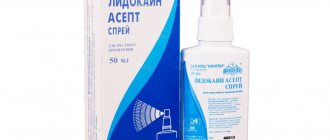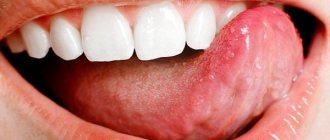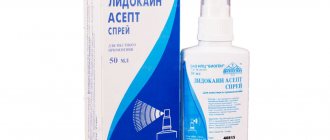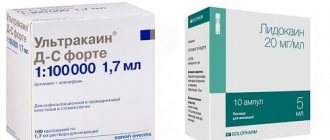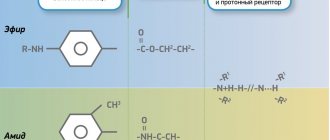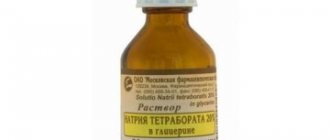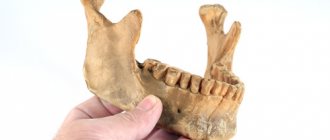Lidocaine spray for local use. dosed 4.6mg/dose 38g
Registration Certificate Holder
SYNTHESIS (Russia)
Dosage form
Medicine - Lidocaine-Akos
Description
Spray for local and external use
in the form of a transparent, colorless or yellowish liquid.
1 dose
lidocaine hydrochloride monohydrate 4.6 mg
Excipients
: ethanol 96% (rectified ethyl alcohol, “Extra” grade) - 18.4 mg, propylene glycol - 4.6 mg, sodium hydroxide - 0.23 mg, sodium saccharinate dihydrate (sodium saccharin) - 0.138 mg, racementol (racemic menthol) - 0.092 mg, water purified - up to 0.046 g.
340 doses - plastic bottles with a spray nozzle (1) - cardboard packs. 650 doses - plastic bottles with a spray nozzle (1) - cardboard packs.
Indications
For terminal (superficial) anesthesia of mucous membranes: in dentistry, in otorhinolaryngology, in obstetrics and gynecology, for instrumental and endoscopic examinations, in surgery and dermatology, radiographic examination (elimination of nausea and pharyngeal reflex).
Contraindications for use
Use for tonsillectomy and adenotomy in children under 8 years of age;
hypersensitivity to lidocaine. With caution
during instrumental studies (rectoscopy) in patients with hemorrhoidal bleeding, local infection in the area of application, trauma to the mucous membrane or skin in the area of application, severe somatic pathology, epilepsy, bradycardia, cardiac conduction disorders, impaired liver function, severe shock, young children, elderly patients, during pregnancy and lactation.
pharmachologic effect
Local anesthetic for superficial anesthesia. The action is due to the blockade of voltage-dependent sodium channels, which prevents the generation of impulses at the endings of sensory nerves and the conduction of pain impulses along nerve fibers.
When applied topically, it dilates blood vessels and does not have a local irritating effect. Has an analgesic effect.
The effect develops 1-5 minutes after application to mucous membranes or skin and lasts 30-60 minutes.
Drug interactions
Cimetidine and propranolol reduce the hepatic clearance of lidocaine (decreased metabolism due to inhibition of microsomal oxidation and decreased hepatic blood flow) and increase the risk of toxic effects (including stunned state, drowsiness, bradycardia, paresthesia).
Barbiturates, phenytoin, rifampicin (inducers of microsomal liver enzymes) reduce effectiveness (an increase in dose may be required).
When prescribed with ajmaline, phenytoin, verapamil, quinidine, amiodarone, the negative inotropic effect may be enhanced. Co-administration with beta-blockers increases the risk of bradycardia.
Curare-like drugs enhance muscle relaxation.
Procainamide increases the risk of developing central nervous system excitation and hallucinations.
With the simultaneous administration of lidocaine and hypnotics and sedatives, their inhibitory effect on the central nervous system may be enhanced.
With intravenous administration of hexobarbital or sodium thiopental against the background of the action of lidocaine, respiratory depression is possible.
Under the influence of MAO inhibitors, the local anesthetic effect of lidocaine may be enhanced.
With the simultaneous use of lidocaine and polymyxin B, an increased inhibitory effect on neuromuscular transmission is possible, so in this case it is necessary to monitor the patient's respiratory function.
Dosage regimen
Apply locally, externally. The dose depends on the indications and the area of the anesthetized surface.
Side effect
Local reactions:
a slight tingling sensation that disappears as the anesthetic effect develops (within 1 minute); Transient erythema, swelling and sensory disturbances may occur.
Allergic reactions:
very rarely - urticaria, angioedema, bronchospasm; in exceptional cases - anaphylactic shock. The use of the drug should be stopped immediately if any allergic reaction occurs.
After topical application, systemic effects rarely develop, because
Only a very small amount of the active substance can enter the bloodstream. From the side of the central nervous system:
very rarely - nervous excitement, systemic dizziness, insomnia, loss of consciousness and respiratory paralysis.
From the cardiovascular system:
decreased blood pressure, depression of myocardial function, bradycardia, cardiac arrest.
special instructions
Use with caution in patients with epilepsy, as well as bradycardia, cardiac conduction disturbances, impaired liver function and severe shock, especially when significant amounts of the drug can be expected to be absorbed when large areas of tissue are treated with high doses.
It is important to prevent lidocaine from entering the respiratory tract (risk of aspiration).
Application to the buccal mucosa is associated with a risk of dysphagia and subsequent aspiration, especially in children. If the sensitivity of the tongue and mucous membrane of the cheeks is impaired, the risk of biting them increases.
Lidocaine is well absorbed through mucous membranes (especially in the trachea) and damaged skin. This should be taken into account, especially when treating large areas of tissue in children.
In cases of use during surgical operations in the pharynx or nasopharynx, it should be taken into account that lidocaine, suppressing the pharyngeal reflex, enters the larynx and trachea and suppresses the cough reflex, which can lead to bronchopneumonia. This is especially important in children, as they are more likely to trigger their swallowing reflex. In this regard, the spray is not recommended for local anesthesia before tonsillectomy and adenotomy in children under 8 years of age.
Caution should be exercised when applying lidocaine to damaged mucous membranes and/or infected areas.
Lower doses should be used in weakened and elderly patients, in acute diseases, as well as in children - in accordance with age and general condition.
Effect on the ability to drive vehicles and machinery
During the treatment period, care must be taken when driving vehicles and engaging in other potentially hazardous activities that require increased concentration and speed of psychomotor reactions.
Use during pregnancy and breastfeeding
Restrictions during pregnancy - With caution. Restrictions when breastfeeding - With caution.
If local anesthesia is necessary and no safer treatment is available, lidocaine can be used during pregnancy.
Lidocaine is excreted in breast milk, but after topical use in normal therapeutic doses, the amount excreted in milk is too small to cause any harm to a nursing infant.
Use for renal impairment
Restrictions for impaired renal function - With caution.
In chronic renal failure, accumulation of metabolites is possible.
Use for liver dysfunction
Restrictions for liver dysfunction - With caution. The drug should be used with caution if liver function is impaired.
Use in elderly patients
Restrictions for elderly patients - Use with caution.
Use with caution in elderly patients.
Use in children
Restrictions for children - Use with caution. Use with caution in children. Use for local anesthesia before tonsillectomy and adenotomy in children under 8 years of age is not recommended.
When is lidocaine indicated?
The range of indications for Lidocaine solution includes the following conditions:
- Local anesthesia required for manipulations in ophthalmology, ENT practice, dentistry, and surgery.
- The use of cephalosporin group of antibacterial drugs as a solvent, the administration of which is characterized by a pronounced pain effect.
Lidocaine for injection allows you to anesthetize the desired area of skin or mucous membrane for several hours, which will be enough for medical manipulation accompanied by increased sensitivity.
Contraindications to the use of lidocaine solution
The use of the drug is prohibited in patients with individual intolerance to the active substance. Lidocaine injections are also prohibited for use in the following conditions:
- The first few months after myocardial infarction.
- Severe cardiac pathologies with bradycardia.
- Infectious process at the injection site.
- Period of pregnancy, lactation.
- Children's age (up to 15 years).
- Convulsions due to epilepsy.
In these conditions, the use of lidocaine solution is not recommended.
Adverse reactions
If used incorrectly, adverse reactions may occur:
- Dizziness, drowsiness, convulsions, sensory disturbances.
- Tinnitus.
- Changes in blood pressure, cardiac dysfunction.
- Nausea, vomiting.
- Feeling of heat, swelling at the injection site.
- Burning sensation, thrombophlebitis.
The list of adverse reactions is much wider, so it is necessary to monitor the patient’s condition after administration of the lidocaine solution.
How is lidocaine solution used?
The local anesthetic solution is pre-tested on a separate area of the skin, which makes it possible to assess the presence or absence of an individual negative reaction to the drug.
The dosage of lidocaine solution depends on the type of anesthesia:
- Terminal type of anesthesia involves local application of a solution (2 mg per kg of body weight), maximum 20 ml for an adult patient. The effect lasts no more than 30 minutes.
- Conduction type of anesthesia. The dosage depends on the size of the area that needs to be anesthetized. Maximum dose 20 ml.
- In ophthalmology, the solution is instilled into the conjunctival sac.
- Epidural anesthesia – 22-30 ml of solution.
- Pain relief in obstetrics and gynecology – 20-30 ml of solution.
- In childhood, the dosage is determined individually (on average 3.5-4 mg per kg of weight).
To prevent the development of side effects, the solution must be administered strictly in recommended dosages. The medication Lidocaine, the instructions for use of which contains all the necessary dosages, must be prescribed after a detailed study of the anamnesis.
special instructions
Lidocaine injection should only be done under the supervision of a physician. Treatment should be carried out under ECG control.
Before starting treatment, it is recommended to examine the level of potassium in the blood, since if its content is reduced, the effectiveness of the drug decreases.
The drug has an effect on the central nervous system, so it is not recommended to drive or engage in potentially life-threatening activities while using it.
Careful monitoring is required for patients prone to seizures, as even small doses may enhance the convulsive effect.
It is necessary to combine lidocaine with caution with those drugs that increase its bioavailability or slow down its elimination, which can be especially dangerous in case of end-stage renal failure.
With intramuscular administration of lidocaine solution, increased activity of creatine phosphokinase may be observed, which prevents the diagnosis of myocardial infarction.
Rapid administration of lidocaine solution can lead to a sharp decrease in blood pressure, with the possibility of collapse. In this case, the toxic effect of the drug with its cardiotoxic effect should also be considered.
Lidocaine in carpules -
All modern anesthetics have not been produced in ampoules for a very long time; they are produced in disposable capsules. The carpule already contains a dose of anesthetic; it is inserted into the carpule syringe (Fig. 1), then a disposable very thin needle is screwed on, and the syringe is ready for anesthesia.
Lidocaine carpule and carpule syringe:
An example of lidocaine anesthesia in carpules is the drug Xylonor, produced by the French company Septadont. But carpules with lidocaine are also produced by other companies. To increase the duration and depth of anesthesia, in addition to lidocaine itself, the anesthetic carpules also contain special additives (epinephrine, adrenaline or norepinephrine), which constrict the blood vessels at the site of anesthesia, thereby preventing the rapid leaching of the anesthetic.
The use of carpule syringes and carpules greatly simplifies the administration of anesthesia for the doctor, and thanks to very thin needles, it reduces pain for the patient. Read all the most detailed information on modern anesthesia in our article: “Everything about anesthesia in dental practice”
Interaction of the solution with other drugs
Lidocaine is not recommended to be combined with the following groups of drugs at the same time:
- Analgesics of the narcotic group - threatens respiratory depression.
- Anticoagulants – increases the risk of bleeding.
- Cardiac glycosides – their effectiveness decreases.
- Novocaine group – increases muscle relaxation.
- The standard is a negative effect on respiratory function.
Lidocaine solution should be combined with extreme caution in diseases of the heart and nervous system, accompanied by systematic use of drugs.
